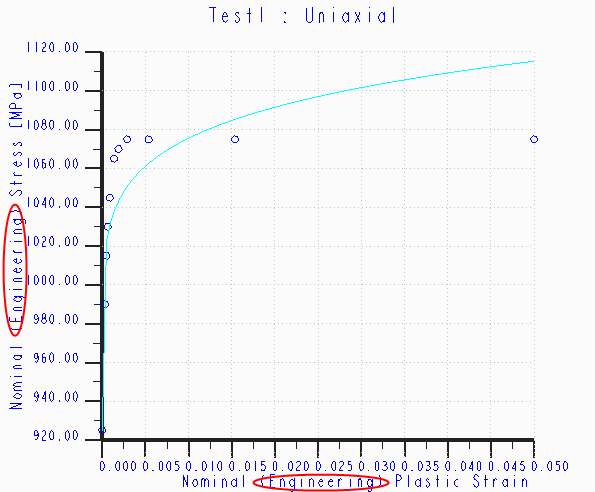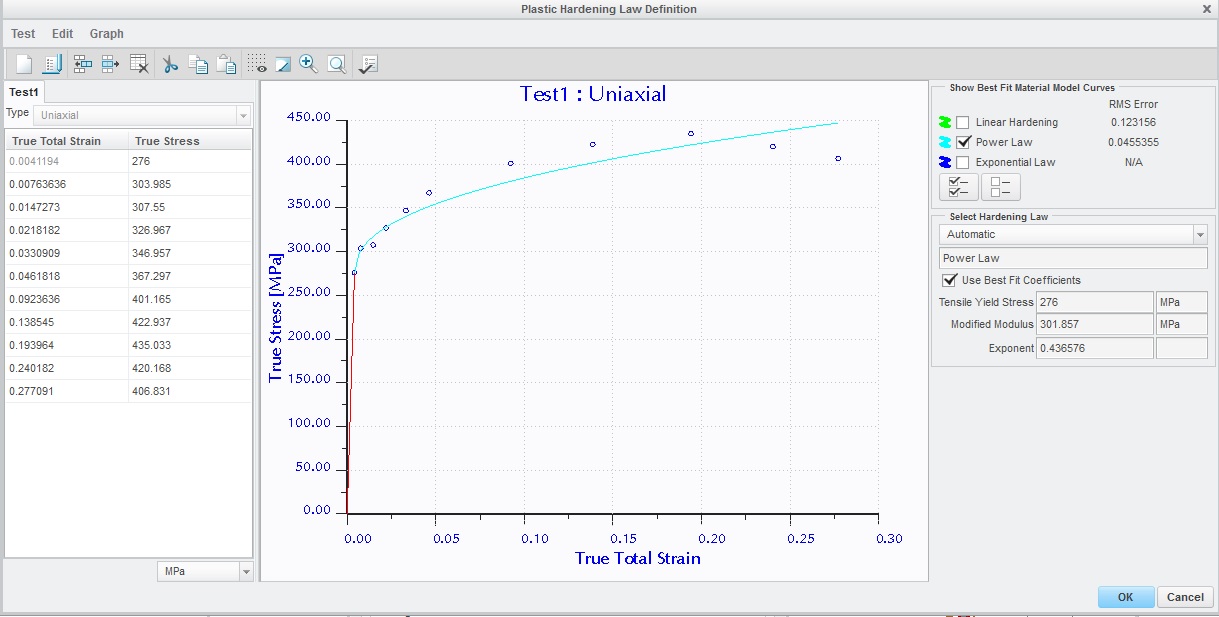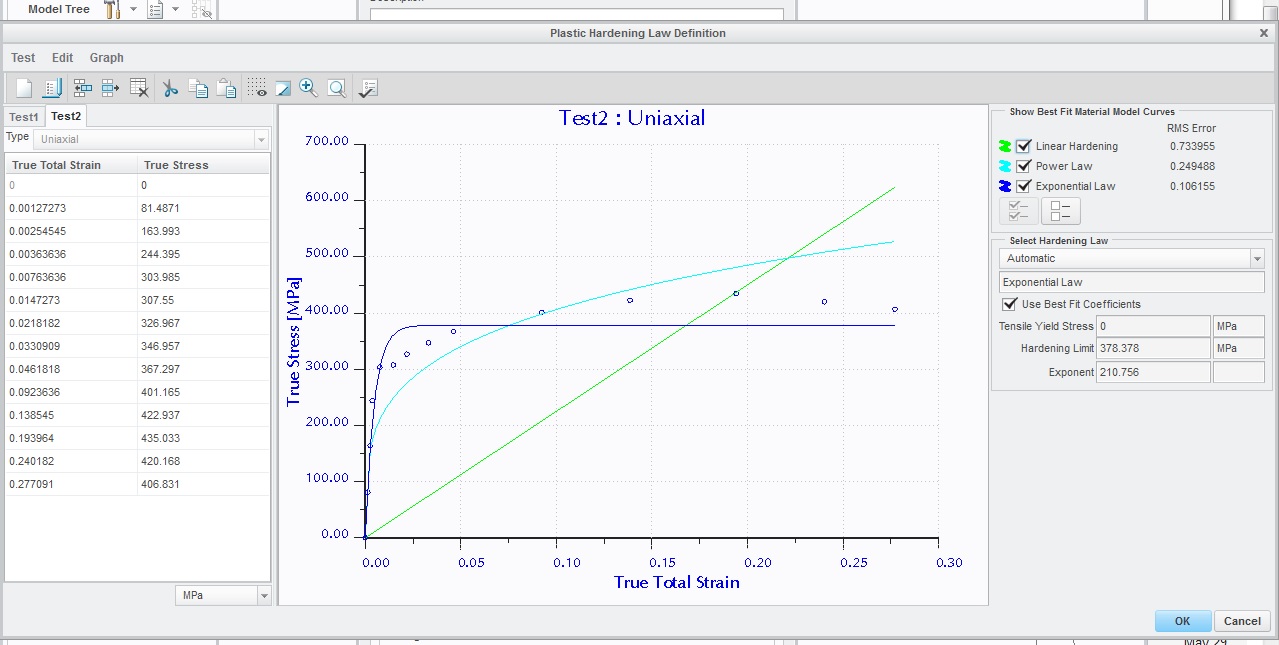- Community
- Creo+ and Creo Parametric
- Analysis
- Re: Stress - strain curves & plasticity
- Subscribe to RSS Feed
- Mark Topic as New
- Mark Topic as Read
- Float this Topic for Current User
- Bookmark
- Subscribe
- Mute
- Printer Friendly Page
Stress - strain curves & plasticity
- Mark as New
- Bookmark
- Subscribe
- Mute
- Subscribe to RSS Feed
- Permalink
- Notify Moderator
Stress - strain curves & plasticity
Hello,
Should we use Engineering or True stress strain curves when carrying out plastic studies?
The material (for context) is steel.
I am assuming one requires True stress strain curves.
Thanks
Solved! Go to Solution.
Accepted Solutions
- Mark as New
- Bookmark
- Subscribe
- Mute
- Subscribe to RSS Feed
- Permalink
- Notify Moderator
Hi Charles,
Yes, the axis labels are incorrect in Creo 2.0 M030. They are corrected in M040, which should ship next month. Here's what it will look like.
Tad
- Mark as New
- Bookmark
- Subscribe
- Mute
- Subscribe to RSS Feed
- Permalink
- Notify Moderator
When entering stress and strain data for elasto-plastic materials, be sure to enter true stress and true plastic strain (not engineering). Also, you need to enter the plastic strain not the total strain. The plastic strain is given by
eps_pl = eps_tot - sigma / E
where
eps_pl is the true plastic strain,
eps_tot is the true total strain,
sigma is the true stress, and
E is Young's moduls
In Creo 3.0, we plan to change the interface so that the user enters true total strain instead of true plastic strain.
Tad Doxsee
PTC R&D
- Mark as New
- Bookmark
- Subscribe
- Mute
- Subscribe to RSS Feed
- Permalink
- Notify Moderator
It was a moment of self doubt when hunting down data to enter.
Thanks for the confirmation.
Charles
- Mark as New
- Bookmark
- Subscribe
- Mute
- Subscribe to RSS Feed
- Permalink
- Notify Moderator
Tad,
The ol' doubt thing is back.
The graph in the input dialogue say's 'Engineering'. see attached image. (this is Creo2.0 m030)
Not having true stress/strain curves I applied a generally accepted correction to the data. (this is not the data in the image which was created just to get the image to show the word 'Engineering')
Thanks
- Mark as New
- Bookmark
- Subscribe
- Mute
- Subscribe to RSS Feed
- Permalink
- Notify Moderator
Hi Charles,
Yes, the axis labels are incorrect in Creo 2.0 M030. They are corrected in M040, which should ship next month. Here's what it will look like.
Tad
- Mark as New
- Bookmark
- Subscribe
- Mute
- Subscribe to RSS Feed
- Permalink
- Notify Moderator
Thanks
- Mark as New
- Bookmark
- Subscribe
- Mute
- Subscribe to RSS Feed
- Permalink
- Notify Moderator
Lawrence,
I am using creo 3.0, and I want to make sure which stress-strain data should I enter to the elastoplastic study.
Is it correct to enter the row data from a typical tensile test starting from the yield stress?

Is it right for both small deformations and large deformations analysis?
Thank you!!
- Mark as New
- Bookmark
- Subscribe
- Mute
- Subscribe to RSS Feed
- Permalink
- Notify Moderator
Mj,
In Creo 3.0 you have to enter true TOTAL strain.
This is the curve data starting from ZERO strain (zero applied load in your test)
Or to put it another way, it is the complete curve from stress=0, strain=0
(Earlier versions of Simulate only requested the yield point and the plastic portion of the stress strain curve)
Note that the requested numbers are TRUE stress and TRUE (log) strain.
Your tests will probably measure ENGINEERING stress and strain. Measurement of TRUE stress is difficult because there has to be a measurement of the cross sectional area to determine the true stress.
Engineering and True strains are close enough for all practical purposes up to 5%.
See page 42 of the link below.
Basics of Elasto-Plasticity in Creo Simulate – Theory and Application
Page 64 of the above link will give you the relationship between TRUE and ENGINEERING. You will therefore need to create a spreadsheet to get from your test data to the data required as input for Creo.
Note that when reviewing Roland Jakel's notes that he was using an earlier version of the software that required only the plastic portion of the stress strain curve as engineering strain. You are going to use the COMPLETE curve.
If you are expecting strains of less than 5% consider whether linear material & small deflection studies could give you the answers you seek. They are much quicker.
Hope this helps
Regards
- Mark as New
- Bookmark
- Subscribe
- Mute
- Subscribe to RSS Feed
- Permalink
- Notify Moderator
Charles,
thank you very much for answer and helpful information.
There is a point that still isn't clear to me: it is about the zero point.
If I try to the complete curve from stress=0, strain=0 it seems to me
(see the attached screenshot) that it takes the zero, zero as yield stress:
- in the parameters of the exponential law the yield stress is zero
- the green line indicating the linear hardening model also starts a (0,0)

Is there something I am doing wrong?
I am using CREO3.0 M050
thank you very much for your attention
- Mark as New
- Bookmark
- Subscribe
- Mute
- Subscribe to RSS Feed
- Permalink
- Notify Moderator
MJ,
The origin is Stress=0, strain=0
The Linear, Power and Exponential laws' coefficients, for the respective laws, are those for a least squares fit.
The software will use the law you select (or selected automatically) and not your curve data.
Firstly,
Visually, none of the laws appear a good fit to your data but I note that your stress reduces with increasing strain.
Stress decreasing with increasing strain suggests you are using Engineering stress. Can you confirm that you are using true stress?
What usually happens is that as necking of a sample begins, the load to increase the strain decreases. It becomes easier to stretch. In Engineering stress we ignore the necking and assume the cross section remains constant. Therefore the stress drops.
With true stress, we consider the reducing cross sectional area of the neck. The neck cross sectional area generally reduces faster than the drop in load and thus true stress rises.

Source : EngArc - L - True Stress, True Strain, Engineering Stress, and Engineerin Strain
If you convert what I think you have entered as Engineering stress/strain to True stress strain, the curve looks more like this

(refer to the link to Roland Jakel's work)
and when you enter it into the software, the software offers the following:

Which looks a bit better.
Secondly,
To answer your question about the yield stress appearing as ZERO. Highlighted above.
You have 2 choices.
1. Allow the software to fit all your entire data set as above
2. Deselect 'use best fit coefficients', enter a yield, select a law and play with the coefficients until happy. See below. NB. I have changed the x-axis range to make the red straight line portion more obvious.

zero to yield will be displayed as a straight red line.
The remaining plastic part of the curve will be modelled using your selected law and coefficients.
It should be noted that yield begins at a stress a lot lower than you think; a lot lower than the published Rp0.2 figures.
atb
Charles
- Mark as New
- Bookmark
- Subscribe
- Mute
- Subscribe to RSS Feed
- Permalink
- Notify Moderator
Hi,
so in Creo 5, for a S235 steel, it is correct what I've inserted?
Why it doesn't calculate the Exponential Law?
PS: for datas I found that grph for S235. I don't know why the yield is near 300MPs instead of 235 (more or less, normally it is a bit more), so I took 250MPa.
Bye
- Mark as New
- Bookmark
- Subscribe
- Mute
- Subscribe to RSS Feed
- Permalink
- Notify Moderator
You are including necking in your stress strain curve. The function must always be increasing.
Also, my opinion is the units might be incorrect on the stress-strain curves. ksi not kN/cm2?
So yield around 210MPa, which is more in line. I tend to agree that the S235 appears to mean minimum 235MPa.
This of course depends on specimen size which also might explain the variance. The material models in Creo also cannot capture the small flat area before strain hardening takes over so you need to decide whether your final fit curve is satisfactory. Sometimes the data entry needs to be massaged.
- Mark as New
- Bookmark
- Subscribe
- Mute
- Subscribe to RSS Feed
- Permalink
- Notify Moderator






